Sushi is a popular dish that has become a staple in many households and restaurants worldwide. However, sushi can be quite tricky to store, and many people often wonder how long sushi can stay in the fridge before it goes bad. The answer to this question is not straightforward, as it depends on various factors such as the type of sushi, storage conditions, and freshness of the ingredients.
Understanding sushi and its storage basics is essential to ensure that you can enjoy it safely and without any health risks. Sushi is a Japanese dish that typically consists of vinegared rice, seafood, and vegetables. Sushi can be served raw or cooked, and it is essential to handle and store it correctly to avoid spoilage and bacterial growth. Proper handling and storage of leftover sushi are crucial so it stays fresh and safe to eat.
Key Takeaways:
- Proper handling and storage of leftover sushi are crucial to ensure that it stays fresh and safe to eat.
- Sushi can be quite tricky to store, and many people often wonder how long sushi can stay in the fridge before it goes bad.
- Understanding sushi and its storage basics is essential so you can enjoy it safely and without any health risks.
Understanding Sushi

Sushi is a popular Japanese dish that has gained popularity worldwide. It is a dish made with vinegared rice and a variety of ingredients like seafood, vegetables, and egg. The dish is typically wrapped in nori, a type of seaweed, and served in bite-sized pieces. Sushi is often served with soy sauce, wasabi, and pickled ginger.
One of the key ingredients in sushi is raw fish. Raw fish used in sushi is typically of high quality and is sourced from reputable suppliers. The raw fish used in sushi is usually frozen to kill any parasites that may be present. Once thawed, the fish is sliced thinly and served raw.
Sushi can also be made with cooked seafood, like shrimp or crab, or with vegetables. Veggie rolls are a popular option for vegetarians and vegans. California rolls, which are made with cooked crab meat, avocado, and cucumber, are also a popular option.
Another important component of sushi is the rice. The rice used in sushi is short-grain rice that has been seasoned with vinegar, sugar, and salt. This gives the rice a slightly sweet and tangy flavor. The rice is cooked and then cooled before being used in sushi.
Sushi can come in different forms, including maki and nigiri. vegetables is made by rolling the rice and ingredients in nori and then slicing them into bite-sized pieces. Nigiri sushi is made by shaping the rice into a small ball and then topping it with a piece of raw fish or other ingredients.
When it comes to storing sushi, it is important to keep it refrigerated. Raw sushi can be stored in the fridge for 1 to 2 days, while cooked sushi can be stored for 3 to 4 days.
Sushi that contains raw fish should be consumed within 12 to 24 hours, while sushi without fish can last for up to a week. It is important to note that freezing sushi can affect its quality and flavor. Store-bought sushi should not be frozen and should be eaten by the best-before date printed on the packaging.
Sushi Storage Basics
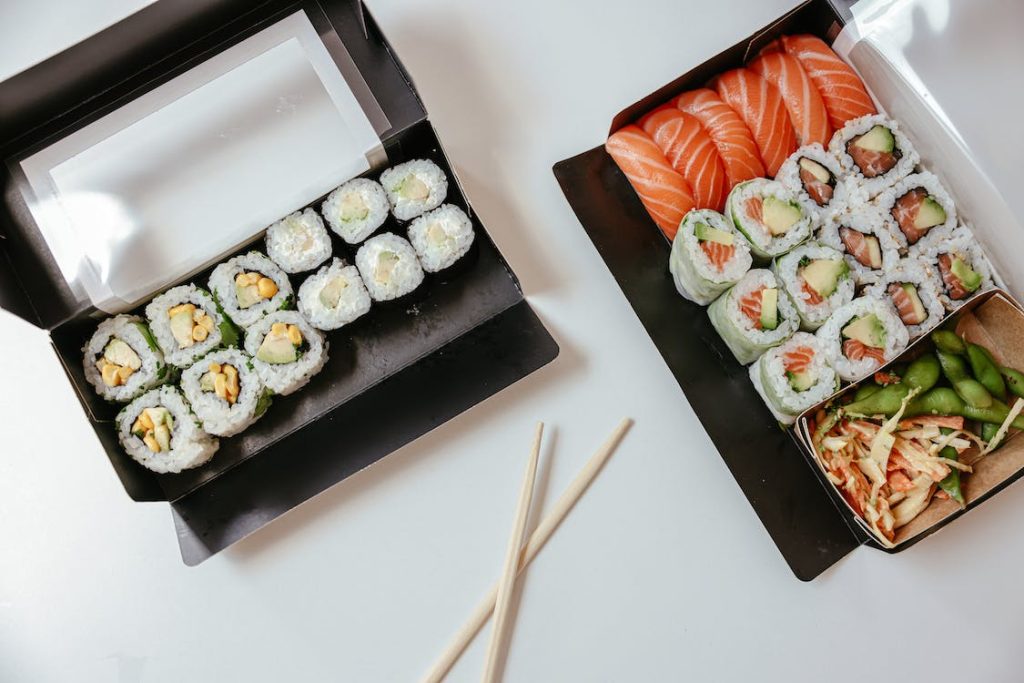
Proper storage is essential for keeping sushi fresh and safe to eat. To maintain the texture and freshness of the sushi, it is important to store it correctly. Here are some basic sushi storage guidelines to follow:
- Always store sushi in an airtight container or wrap it tightly in plastic wrap or foil to prevent air and moisture from getting in.
- Store sushi in the fridge at a temperature between 35°F and 45°F. Raw sushi should be consumed within 24 hours, while cooked sushi can last for up to four days in the fridge.
- Do not store sushi at room temperature for more than two hours, as bacteria can grow rapidly at temperatures between 40°F and 140°F.
- Leftover sushi can be stored in the fridge for up to four days, but it is best to consume it within 24 hours for optimal freshness.
- To prevent the sushi from becoming dry, place a damp paper towel in the container or wrap it in foil before storing it in the fridge.
- Freezing sushi can affect its texture and flavor, but if necessary, it can be stored in the freezer for up to two months.
By following these sushi storage basics, you can ensure that your sushi stays fresh and safe to eat. Remember to always use airtight containers or wrap the sushi tightly to prevent air and moisture from getting in, and store it in the fridge at the appropriate temperature.
Sushi Shelf Life and Spoilage Indicators
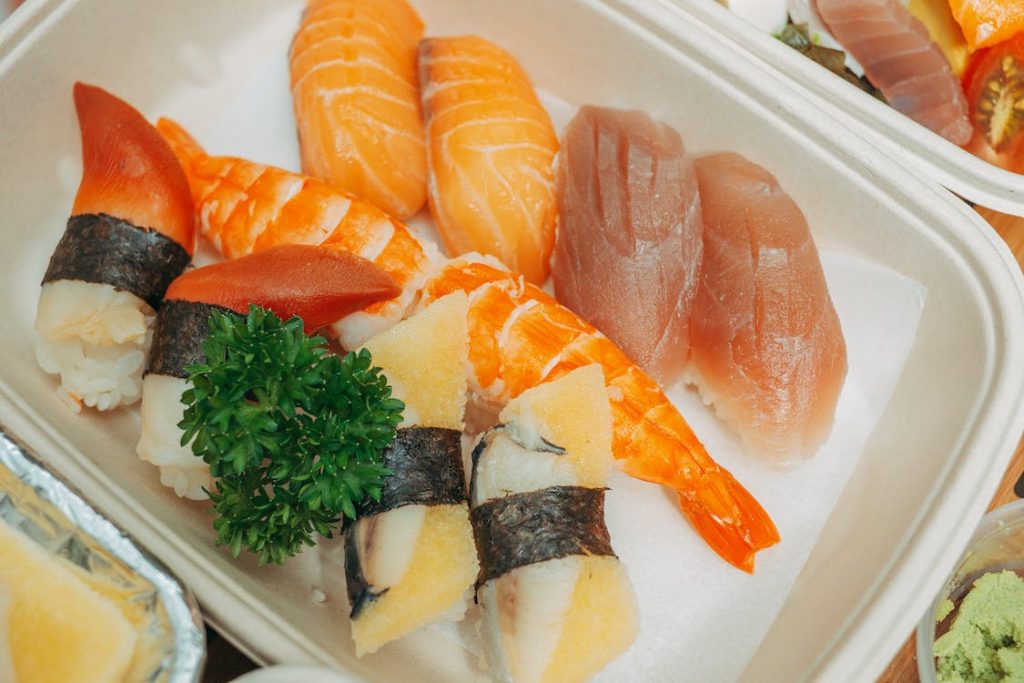
Sushi is a popular Japanese dish that consists of vinegared rice, raw or cooked seafood, and vegetables. It is a delicate dish that requires proper handling and storage to maintain its flavor and freshness. In this section, we will discuss the shelf life of sushi and the indicators of spoilage.
Shelf Life of Sushi
The shelf life of sushi depends on the type of sushi and how it is stored. Raw sushi can be stored at room temperature for up to 2 hours and in the fridge for 1 to 2 days, but cooked sushi can be stored for 3 to 4 days in the fridge [1]. If you freeze sushi, it will last for about one to two months [2].
Spoilage Indicators
It is important to know the indicators of spoilage to avoid consuming spoiled sushi and prevent food poisoning. Here are some signs that your sushi has gone bad:
- Odor: If your sushi smells sour or fishy, it is a sign that it has gone bad.
- Slimy surface: If your sushi has a slimy surface, it is a sign that it has spoiled.
- Texture change: If the texture of your sushi has changed, it may be a sign that it has gone bad.
- Spoiled sushi rice: If the sushi rice has a sour smell or slimy texture, it may be a sign that it has gone bad.
- Bacterial growth: If you see any signs of bacterial growth, such as mold or discoloration, it is a sign that your sushi has gone bad.
It is important to note that sushi can still be unsafe to eat even if it does not show any signs of spoilage. Always check the expiration date and follow proper food safety guidelines when handling and storing sushi.
In summary, sushi has a limited shelf life and requires proper handling and storage to maintain its freshness. Knowing the indicators of spoilage is essential to avoid consuming spoiled sushi and prevent food poisoning.
References
- How Long Does Sushi Last? – Healthline
- How Long Does Sushi Last? 11 Signs Sushi Has Gone Bad – Sustainable Sushi
The Impact of Sushi Quality on its Shelf Life
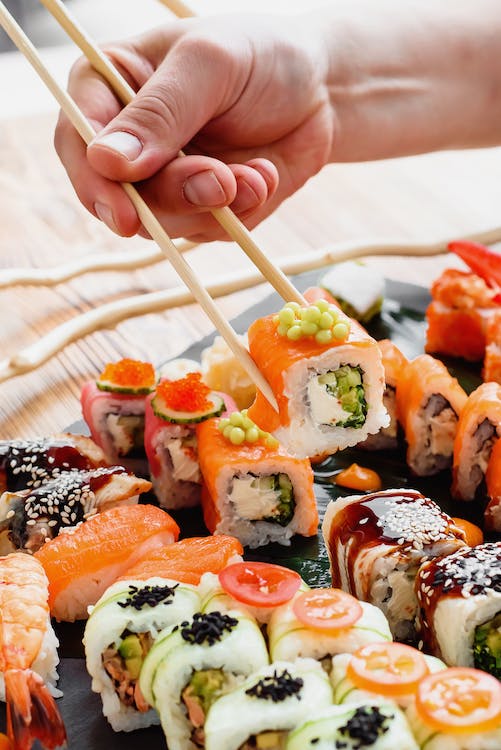
Sushi is a popular Japanese dish that consists of vinegared rice, seafood, vegetables, and other ingredients. Sushi is known for its unique taste, texture, and freshness. However, sushi is also a perishable food that can spoil quickly if not stored properly. The quality of sushi has a significant impact on its shelf life.
Freshness is the key factor that determines the quality of sushi. Fresh fish has a longer shelf life than stale or old fish. Therefore, it is important to use fresh fish when making sushi. Sushi grade fish is a term used to describe fish that has been caught, handled, and processed in a way that makes it safe to eat raw. Sushi grade fish is usually fresher than other types of fish and has a longer shelf life.
Oxidation and moisture migration are two factors that can affect the quality of sushi. Oxidation occurs when oxygen reacts with the fish’s fats and proteins, causing them to break down and become rancid. Moisture migration occurs when moisture moves from one part of the sushi to another, causing it to become dry or soggy. To prevent oxidation and moisture migration, sushi should be stored in an airtight container and wrapped tightly in plastic wrap.
Sushi can be stored in the fridge for up to four days if it is made with fresh fish and stored properly. However, the shelf life of sushi can vary depending on its quality and how it is stored. Cooked sushi can last longer than raw sushi because it has been cooked, which kills bacteria and other microorganisms that can cause foodborne illness.
In summary, the quality of sushi has a significant impact on its shelf life. Freshness, sushi grade fish, oxidation, and moisture migration are all factors that can affect the quality of sushi. Proper storage is also important to prevent spoilage and foodborne illness. Sushi can be stored in the fridge for up to four days if it is made with fresh fish and stored properly.
Proper Handling and Storage of Leftover Sushi
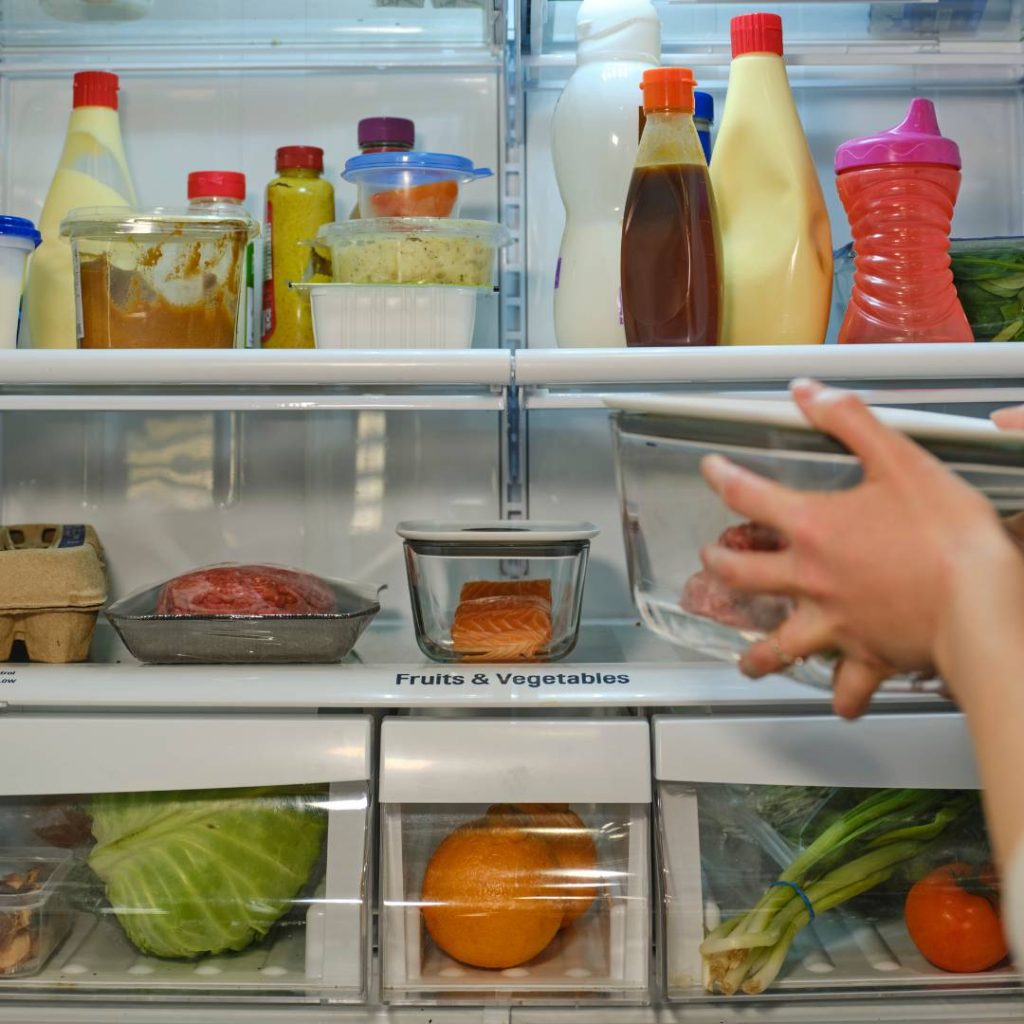
When it comes to leftover sushi, proper handling and storage are crucial to maintain its quality and safety. Here are some tips to help you store your leftover sushi safely:
- Wrap it tightly. Raw fish and seafood, including sushi, should be tightly wrapped in plastic wrap, foil, or moisture-proof paper. This will help prevent air and moisture from getting in and causing it to spoil faster.
- Store it in an airtight container. After wrapping your leftover sushi, store it in an airtight container. This will help keep it fresh and prevent any odors from other foods in the fridge from seeping in.
- Keep it in the coldest part of the fridge. Sushi should be stored in the coldest part of the fridge, usually the back or bottom shelf. This will help keep it at a consistent temperature and prevent any bacteria from growing.
- Don’t keep it for too long. Leftover sushi should be consumed within 24 hours of being made. Any longer than that, and it may start to lose its freshness and flavor.
- Freeze it if necessary. If you can’t eat your leftover sushi within 24 hours, you can freeze it. Make sure to wrap it tightly in plastic wrap or foil and store it in an airtight container before placing it in the freezer. When you’re ready to eat it, let it thaw in the fridge overnight.
- Reheat it carefully. If you want to reheat your leftover sushi, do it in the microwave or oven. Make sure to wrap it in a damp paper towel and heat it on low power to prevent it from drying out or becoming tough.
Proper handling and storage of leftover sushi are essential to ensure its quality and safety. By following these tips, you can enjoy your leftover sushi without worrying about getting sick or it going bad.
Special Considerations for Different Types of Sushi

When it comes to sushi, different types have different shelf lives. Here are some special considerations for different types of sushi:
Vegetarian Sushi
Vegetarian sushi, such as cucumber rolls or avocado rolls, can last in the fridge for up to 48 hours. Since they do not contain any raw fish, the risk of spoilage is lower. However, it is still important to properly store them in an airtight container and consume them within two days.
Cooked Fish Sushi
Cooked fish sushi, such as tempura shrimp rolls, can last in the fridge for up to 72 hours. Cooked fish has a longer shelf life than raw fish. But it is still important to properly store it in an airtight container and consume it within three days.
Veggies
Sushi rolls that contain only vegetables, such as cucumber or carrot rolls, can last in the fridge for up to 48 hours. However, it is important to note that some vegetables, such as avocado, can spoil quickly. Make sure to properly store your veggie sushi in an airtight container and consume it within two days.
Dragon Rolls
Dragon rolls, which typically contain eel and avocado, can last in the fridge for up to 48 hours. However, it is important to note that eel has a shorter shelf life than other types of cooked fish. Make sure to properly store your dragon rolls in an airtight container and consume them within two days.

Konnichiwa! (Hello!) I'm Pat Tokuyama, a Japanese tofu cookbook author, who travels for music, food, and adventure. If you like Japanese tea, checkout some of the newestorganic japanese tea, matcha bowls and noren and more!
** Curious about the Plant Based Japanese Cooking Club? ** Learn more here!
Salmon Sashimi
Salmon sashimi should not be stored in the fridge for more than 24 hours. Raw fish has a shorter shelf life than cooked fish and can spoil quickly. It is important to consume salmon sashimi as soon as possible after it is prepared.
In summary, it is important to properly store your sushi in an airtight container and consume it within the recommended time frame. Cooked fish sushi has a longer shelf life than raw fish sushi, and vegetarian sushi has a lower risk of spoilage. It is also important to note that some ingredients, such as avocado and eel, have shorter shelf lives and should be consumed within two days.
Food Safety Regulations and Guidelines

When it comes to sushi, food safety is of utmost importance. The U.S. Food and Drug Administration (FDA) and the U.S. Department of Agriculture (USDA) have set guidelines and regulations to ensure that sushi is safe for consumption.
One important factor to consider is the “danger zone” temperature range, which is between 40°F and 140°F. This is the temperature range in which bacteria can grow rapidly and cause foodborne illness. Therefore, it is important to keep sushi refrigerated below 40°F to prevent the growth of harmful bacteria.
The USDA recommends that raw fish, such as sushi or sashimi, be frozen at -4°F for at least seven days or at -31°F until solid and then stored at -4°F or below for 15 hours to kill any parasites that may be present. Additionally, the FDA advises against consuming raw or undercooked finfish or shellfish, including oysters, clams, and mussels, as they are more likely to contain parasites or bacteria than cooked fish.
According to food safety rules, NSW Food Authority allows sushi shops to sell sushi under 25°C for four hours max if they follow guidelines. These guidelines involve hygienic preparation and display, and keeping sushi below 25°C for under four hours.
It is important to note that sushi should not be left at room temperature for an extended period of time, as this can lead to the growth of harmful bacteria. Eat leftover refrigerated sushi within two days below 40°F. Discard sushi left at room temperature for over two hours.
Overall, following food safety regulations and guidelines is crucial in ensuring that sushi is safe for consumption.
Buying Sushi from Supermarkets and Restaurants
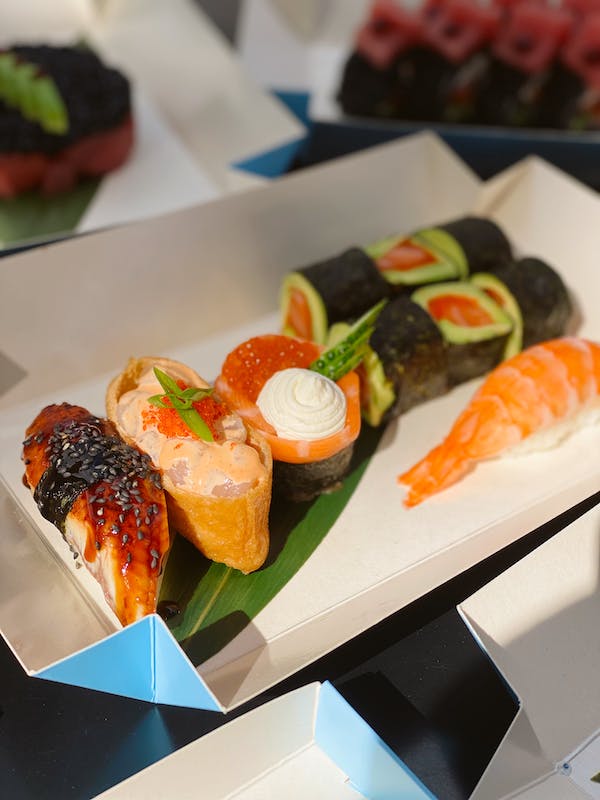
If you’re buying sushi from supermarkets or restaurants, it’s essential to know how long it can stay in the fridge before it goes bad. According to sushi experts like Eric Jue and Brian Chau, refrigerated sushi that contains raw seafood should be consumed within 12 to 24 hours, which is the standard recommendation at supermarkets in Japan PureWow. The same is true for sushi bought in the U.S., be it from a grocery store or restaurant.
If you’re buying store-bought sushi that contains cooked ingredients or vegetables, it can stay good for more than three days when refrigerated, according to Easy Homemade Sushi. However, if the sushi contains raw fish, it can only last for 24 hours when refrigerated. As a rule, you must not eat sushi if it has been left outside for more than two hours at room temperature.
When buying sushi from a grocery store or restaurant, always check the expiration date on the label. Surprisingly, the biggest health hazard associated with sushi is not the raw fish, but rather the rice. If the rice is not cooked properly or left out for too long, it can develop harmful bacteria that can cause food poisoning The List.
To ensure that you’re buying safe and fresh sushi, it’s recommended that you buy it from reputable sources that have a good track record of food safety. If you’re buying sushi from a restaurant, make sure that it’s prepared fresh and not sitting out for too long. And according to the Sushi Making Kit, if you’re buying sushi from a grocery store, check to see if it’s kept in a refrigerated case and not sitting out at room temperature for too long.
In summary, when buying sushi from supermarkets and restaurants, it’s essential to know how long it can stay in the fridge before it goes bad. Always check the expiration date on the label, and buy from reputable sources that have a good track record of food safety.
Risks of Consuming Spoiled Sushi

Sushi is a popular and delicious dish that many people enjoy. However, consuming spoiled sushi can lead to food poisoning, which can cause a range of symptoms such as stomach cramps, diarrhea, nausea, and vomiting. In this section, we will discuss the risks of consuming spoiled sushi and how to avoid them.
One of the main risks of consuming spoiled sushi is the presence of bacteria. Raw fish used in sushi can contain harmful bacteria such as Vibrio, Salmonella, and Listeria. When sushi is not stored properly, these bacteria can multiply and cause foodborne illness. Symptoms of food poisoning from bacteria in sushi can range from mild to severe, and in some cases, can even be life-threatening.
Another risk of consuming spoiled sushi is the presence of parasites. Raw fish used in sushi can contain parasites such as Anisakis, which can cause allergic reactions and gastrointestinal symptoms. Symptoms of Anisakis infection can include stomach pain, vomiting, and diarrhea.
To avoid the risks of consuming spoiled sushi, it is important to ensure that the sushi is fresh and properly stored. Sushi should be consumed within two hours of being prepared, or within one day if stored in the fridge. Cooked sushi can be stored for up to four days in the fridge.
When consuming sushi, it is important to pay attention to its appearance, smell, and taste. Spoiled sushi may have a sour or ammonia-like smell or a slimy texture. If sushi looks or smells off, it is best to avoid consuming it.
In conclusion, consuming spoiled sushi can lead to food poisoning and other health risks. To avoid these risks, it is important to ensure that sushi is fresh and properly stored and to pay attention to its appearance, smell, and taste. By following these guidelines, you can safely enjoy this delicious dish.








Konnichiwa! (Hello!) I'm Pat Tokuyama, a Japanese tofu cookbook author, who travels for music, food, and adventure. If you like Japanese tea, checkout some of the newestorganic japanese tea, matcha bowls and noren and more!
** Curious about the Plant Based Japanese Cooking Club? ** Learn more here!